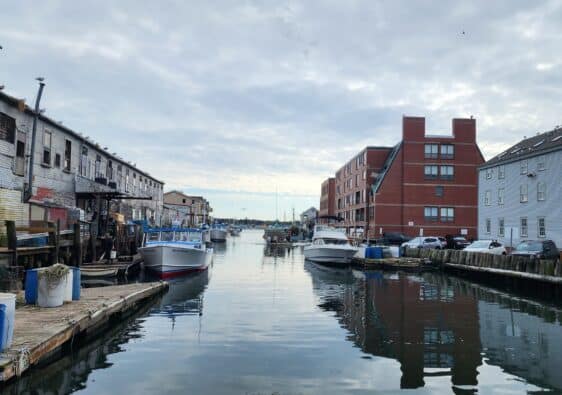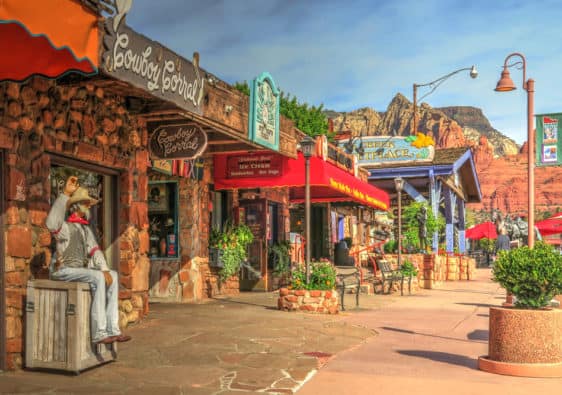Everything You Need to Know to Visit Arizona in the Winter
Planning a trip to Arizona in February? This guide will help you learn all about Arizona’s diverse climate and how to make the most of your trip this time of year.

Ready to escape the winter chill and embark on an unforgettable adventure to the diverse landscapes of Arizona in February? Usually known for its scorching summer heat, Arizona becomes a delightful place to visit in the second month of the year.
With perfect temperatures and a myriad of outdoor activities, there are a million reasons why Arizona is a great place to visit in the winter.
From the iconic red rocks of Sedona to the majestic Grand Canyon, February offers a unique blend of mild weather, cultural events, and natural wonders.
Whether you’re a snowbird seeking a warm retreat or an adventure enthusiast looking to explore the rich tapestry of the Southwest, Arizona in February promises an experience like no other.
I moved to Arizona for college and ended up sticking around for a full decade to enjoy all there is to see and do in this southwestern state. A lot of my family lives in Arizona, so even though I moved to New York, I still go back often. And I still love to explore all the hidden gems and eclectic towns dotted throughout State 48.
In this blog, I’ll guide you through why Arizona is a great place to visit in February. I’ll give you the low down on the weather in different parts of the state, and navigate you through the top destinations, activities, and hidden gems that make February the perfect time to discover the wonders of the Grand Canyon State.

Top Things To Do In Arizona In February
✨ Sunset Hot Air Balloon Ride Over Phoenix
⭐ Small-Group or Private Grand Canyon with Sedona Tour from Phoenix
- Guide To Visiting Arizona in February
- Why Visit Arizona in February?
- Arizona Weather in February
- Winter Driving in Arizona
- Winter Safety Tips for Arizona Visitors
- Top Arizona Winter Destinations: What To Explore & Things To Do
- What To Pack When Visiting Arizona in February?
- Frequently Asked Questions About Visiting Arizona in February
- Final Thoughts on Visiting Arizona in the Winter
Guide To Visiting Arizona in February
February is the perfect time of year to visit Arizona. The weather is perfect and there is so much to see and do. So, let’s dive into everything you need to know to plan the perfect winter getaway to Arizona.
Why Visit Arizona in February?
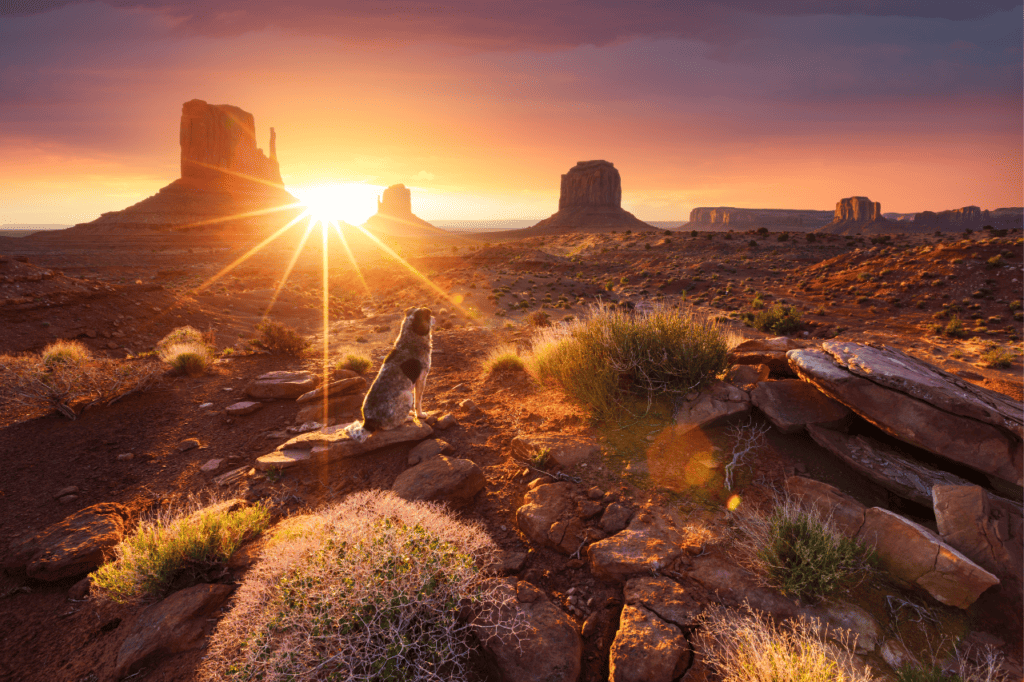
Take it from a girl who lived in Arizona for more than 10 years: Arizona has perfect weather in February.
Unlike most other places in the U.S. where there is bound to be snow and windy chills, like New York City, Arizona is an average of 72° F in February. It’s the perfect getaway from cold climates in other parts of the country.
But the flawless weather isn’t the only thing that makes Arizona great in the second month of the year.
Despite being a winter high-season destination, Arizona avoids the high congestion caused by an incoming flock of snowbirds that other places get in the winter. Sure, AZ gets a fair amount of winter migraters, but it’s nothing like the traffic in Florida this time of year.
Another reason Arizona is so great in the wintertime is you have the chance to experience whatever type of climate you want. If you stay in Phoenix, you’ll get to experience an early spring with desert flowers blooming everywhere you turn. If you visit Northern Arizona, you’ll still find snow-capped mountains in Flagstaff.
You’d be hard-pressed to find another state where you can ski on powdery mountain peaks on one day of your vacation and hike in a sunny desert the next day.
So, between the diverse climate, excellent weather, and lack of congestion seen in other destinations this time of year, Arizona is an ideal location for your mid-winter vacation.
Arizona Weather in February
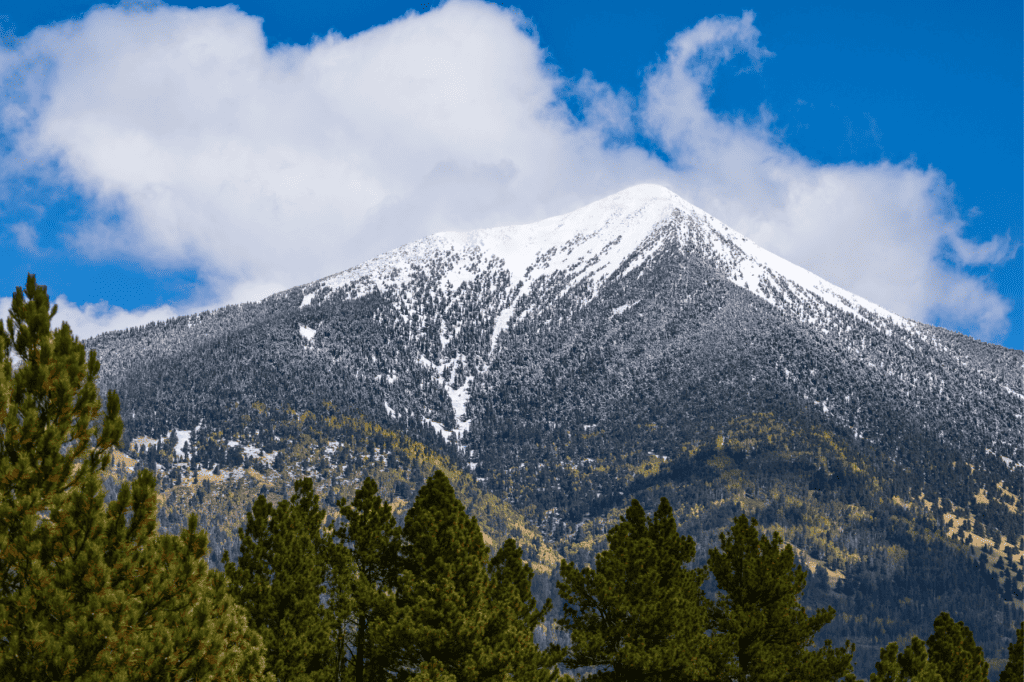
While February in the rest of the U.S. is still in the depths of winter, in Arizona it’s the beginning of spring.
In general, the state falls somewhere in the low 70s F throughout the month with nighttime temperatures lowering to the low 40s. But like any place, Arizona occasionally gets some freaky weather. Like in 1921 when the temperature soared to 92° F, the highest temperature for February on record.
Based on averages, here is what the weather in different parts of Arizona is like in February:
Winter Weather in Northern Arizona
At approximately 7,000 feet in elevation, both the Flagstaff area and the south rim of the Grand Canyon experience the coldest weather in Arizona. In February, the average high temperature falls in the mid-40s, with lows dipping into the 20s.
Northern Arizona is a fantastic choice for classic winter activities like skiing at Arizona Snowbowl and Sunrise Park resorts. It’s also a bucket list sight to see the Grand Canyon or the red rock mountains of Sedona covered in snow. Plus, in the winter, these national monuments are less likely to be crowded with tourists.
Winter Weather in Central Arizona
Central Arizona experiences mild nights in the mid-40s, while daytime temperatures reach around 70 with clear, sunny skies. The delightful weather provides an ideal opportunity to explore the numerous desert hiking trails and golf courses in the Phoenix area.
Visiting Central Arizona this time of year is great because you can pack light and leave all your winter clothes behind.
🧳 To learn more about what to pack for your Arizona trip, check out my Arizona Packing Guide.
Winter Weather in Southern Arizona
If February’s snow and cold aren’t your preference, head to Southern Arizona for milder conditions. In Tucson, temperatures are slightly cooler than in Phoenix, offering hundreds of miles of hiking trails amid the five surrounding mountain ranges.
Explore the Biosphere in Oracle, or, if you have a change of heart for snow, experience skiing at Mount Lemmon just north of Tucson. Venturing farther south towards Bisbee and Tombstone, enjoy daytime temperatures in the mid-60s and nights near freezing—perfect for exploring the Old West during the day and cozying up at night.

Winter Driving in Arizona

Navigating Southern and Central Arizona in winter is generally straightforward because it’s like driving anywhere else on a beautiful spring day.
But if you find yourself on the I-17 or 101 during rush hour, you’ll probably find yourself stuck in traffic. While Phoenix has the Valley Metro Rail, it’s not the best public transportation system and most of the locals get around by car. This can lead to congestion on the freeways, especially when people are heading to and from work.
In Northern Arizona, driving conditions differ, with the possibility of snow. Check weather reports before your journey and exercise caution on icy roads or mountainous routes with hairpin turns. If venturing through snowy mountains, consider using tire chains. You might not have a choice in some places as some roads will require chains by law.
Winter Safety Tips for Arizona Visitors
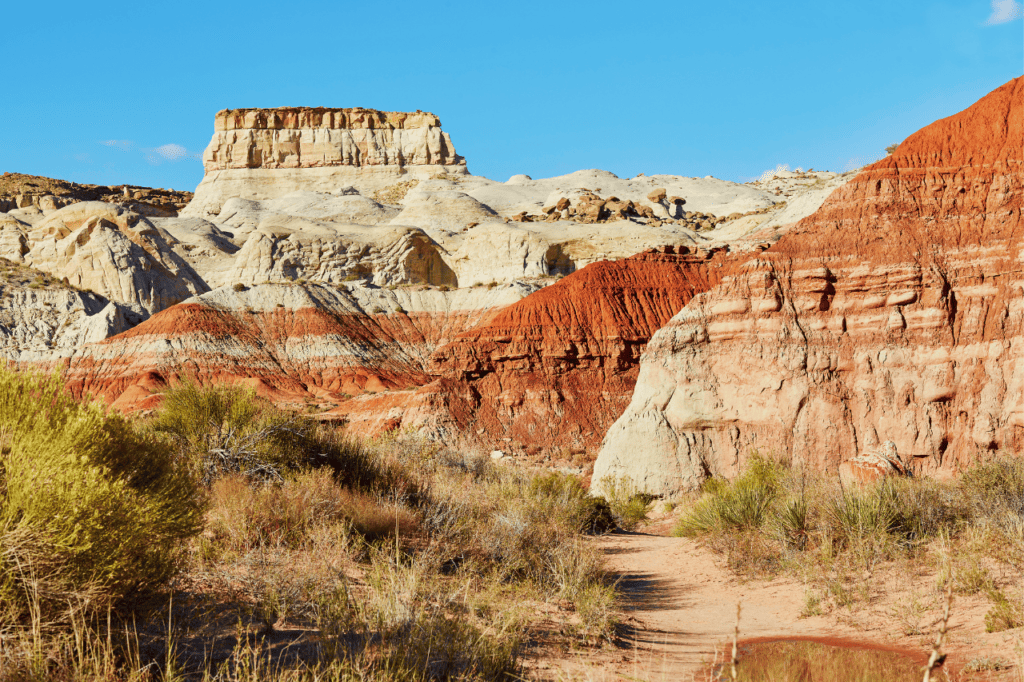
There is a wide selection of outdoor activities to choose from in Arizona. From skiing in snow-capped mountains to hiking across desert landscapes, it’s important to keep safety a top priority while enjoying your adventures.
Arizona offers numerous National Parks, Monuments, State Parks, and open federal lands, including scenic spots on tribal reservations accessible to the public. Exercise caution, especially in remote areas, as safety risks persist throughout the year, with dehydration, frostbite, getting lost, and trail injuries leading to rescues.
Winter hiking in Arizona demands adequate water supplies and layered clothing. While daytime temperatures may be warm, nights can freeze. So if you plan on camping in Arizona in February, make sure to bring suitable camping supplies to keep you warm and toasty.
Check the weather, especially in mountainous areas, where unexpected snow, sleet, and rain may occur. Pack moisture-wicking fabrics, hats, sunscreen, and winter hiking gear, and always be mindful of sunset times during day hikes to ensure a safe return to your car.
If you’re traveling alone, make sure to use common sense by letting people know where you are going and checking in when you get back. Avoid poorly lit or isolated areas, keep valuables secure, and trust your instincts in uncomfortable situations.
It’s also a good idea to exercise discretion on social media, especially regarding real-time location updates. Secure your lodging, stay updated on weather conditions for outdoor activities, and always prioritize personal safety during your solo journey.
Arizona’s desert climate is exceptionally dry, with winter humidity often plunging into the low single digits, posing challenges for your skin. First-time visitors should prepare with essentials like eye drops, lip balm, and moisturizer. Hydration is crucial, even if you’re not exercising.
Top Arizona Winter Destinations: What To Explore & Things To Do
Arizona is the dream destination for anyone seeking a winter escape. It’s the perfect place to visit in February and not just because lucky State 48 shares a birthday with Valentine’s Day (it became a state on February 14, 1912). Arizona offers an array of adventures, from hiking amidst towering cacti to conquering ski slopes.
Spanning 113,998 square miles, Arizona boasts vast deserts, canyons, and mountains, providing a spectrum of experiences. Whether you’re chasing the sun or embracing snowy landscapes, there is plenty to explore and do in Arizona in February.
Things to do in Northern Arizona in February
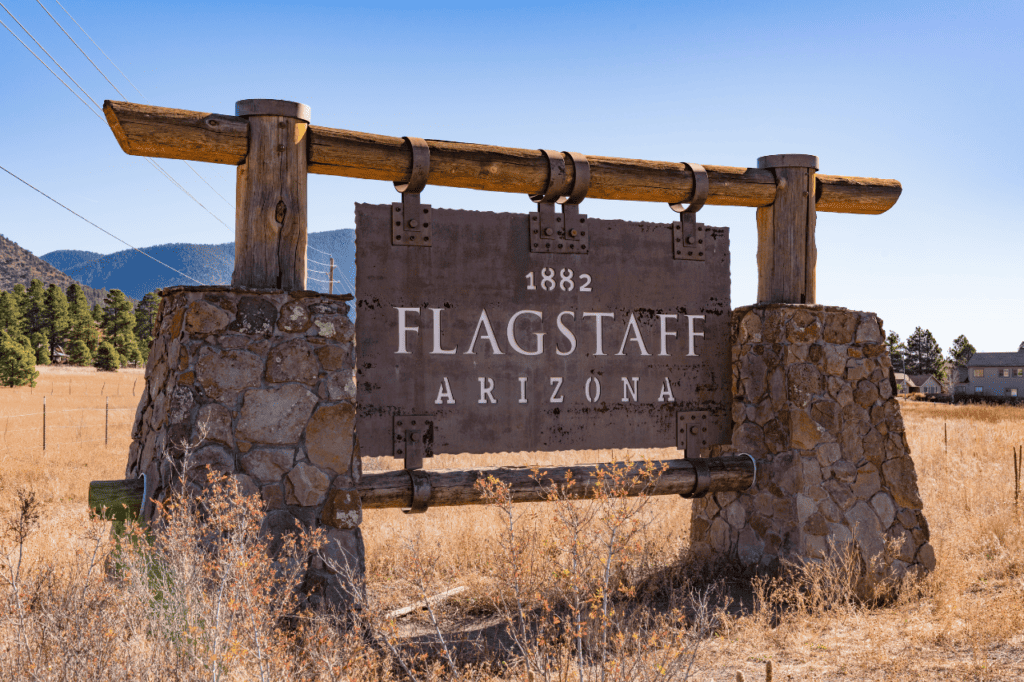
Exploring Northern Arizona in February provides a chance to discover some of the most scenic destinations in the state with reduced crowds. While this southwestern state is known for its heat year-round, Northern Arizona still finds a bit of a winter chill.
If you make your way up to Flagstaff, you might even find yourself marching through several inches of snow. Meanwhile, even Sedona receives a delicate powdering of snow over the red rocks. A winter visit to Northern Arizona offers more flexibility in terms of accommodations, restaurant reservations, and guided tours, making it a convenient getaway.
Visit Sedona
Nestled in the Coconino National Forest and made up of captivating red rock mesas and dense Ponderosa pine tree forests, Sedona is a travel hotspot. Even though it’s only home to 10,000 people, Sedona receives three million visitors annually.
The tourist high season is from late spring to early fall, so February is one of the best months to visit Sedona. With fewer crowds and daytime highs hovering in the 60s, it’s the perfect time of year to go hiking or explore the downtown art boutiques and New Age stores.
The biggest benefit to visiting Sedona in February is being able to hike with fewer crowds.
Some of my favorite hikes include:
- Soldier Pass Trail
- Seven Sacred Pools
- Birthing Cave
- Cathedral Rock
- Bell Rock Loop
- Devil’s Bridge
➡️ Discover one of my favorite places in the world with my guide to the Amitabah Stupa and Peace Park in Sedona.
Other fun things to do in Sedona include stargazing in one of the world’s few Dark Sky Communities, embarking on a scenic drive along the Red Rock Scenic Byway, or opting for an exhilarating Jeep tour through desert canyons.
🏜️ Explore the red rocks of Sedona on the back of a jeep that takes you off-road for the best sights of some of Sedona’s most magnificent scenery. Click here to reserve your spot.
I grew up visiting Sedona regularly and this town holds a special place in my heart. If you find yourself in Arizona with some time to visit Sedona, I highly recommend stopping by.
How to Get to Sedona: Sedona is a straight shot North of Phoenix on the I-17. Exit onto the 179 and continue on the highway until you reach the downtown district.
➡️ 🧳 Plan The Perfect Day Trip To Sedona Using Our Free Guide!
Explore Jerome
Jerome used to be a former copper mining town and now it’s an artsy retreat filled with hippies and creatives. Like Sedona, Jerome can get a little chilly in the winter, but the average temperatures hover in the low 50s, which is much better than many other parts of the world this time of year.
The Old West ambiance intertwines seamlessly through this mountain town. Once on the brink of becoming a ghost town, Jerome’s resilience shone through as artists and residents revitalized it. Today, restored buildings, unique boutiques, wineries, and saloons line its winding streets.
Dive into the town’s mining history at the former Douglas Mansion. Or chance meeting a spirit from the past while taking a guided ghost tour in this real haunted town.
➡️ Jerome is known for being one of the most haunted towns in the country. Using professional equipment, see if you can connect to the spirits across the veil. Reserve your spot on this guided ghost tour if you dare! 👻
Stop by the Nellie Bly shop to see some incredible local art for sale or gander at some wicked cool hand-made kaleidoscopes. Don’t miss the Jerome Artists Cooperative Gallery for more local art. The Mine Cafe is a great place to stop for lunch for excellent vegetarian and vegan dishes.
The Jerome Art Walk, held on the first Saturday of each month, provides a fantastic opportunity to explore local art and meet artists.
Whether you’re a history buff, art enthusiast, or thrill-seeker, this quirky town offers something special during the festive season.
How to Get to Jerome: Just two hours north of Phoenix, Jerome is also a straight shot up the I-17. This time, exit to the 260 and follow the highway through Cottonwood to the 89A.
Wander Downtown Flagstaff
Mikey and I have family in Flagstaff, so we visit this cute little mountain town often. It’s amazing all year, but it’s an especially superb choice for anyone looking for a little winter wonderland in the Southwest.
If you’re looking for snow in Arizona, Flagstaff is your best bet. This town receives over 100 inches of snow annually, and they get even more than that in the surrounding mountains.
In February, Flagstaff reaches lows of 19° F and highs of 47° F. January is Flagstaff’s snowiest month, but you’re still likely to catch a few flakes in February.
In a state where snow may not be the first association, Flagstaff stands out as Arizona’s only destination for skiing and snowboarding. The Arizona Snow Bowl, the primary resort in the area, offers 777 acres of ski-able terrain, featuring 55 runs and 8 lifts.
With an impressive average snowfall of 260 inches, the Arizona Snow Bowl guarantees a lengthy season from late November through spring.
How to Get to Flagstaff: Flagstaff is one of the easiest places to find because all you have to do is get on the I-17. Keep following the freeway North and eventually, it will end right at the entrance to Flagstaff.
See the Petrified Forest National Park
Nestled in the northeastern corner of Arizona, Petrified Forest National Park is often overlooked. While it may not boast the dramatic landscapes of Sedona or the Grand Canyon, it’s a forest of beauty. This historic national park’s charm lies in colorful badlands, expansive desert vistas, and ancient crystallized wood forests.
Exploring the park reveals captivating hikes like the Blue Mesa trail, leading below the rim of a mesa amid indigo-colored badlands towering overhead.
Beyond hiking, the Petrified Forest offers something for everyone. History enthusiasts can marvel at Newspaper Rock’s 650 petroglyphs, some dating back over 2,000 years. Geology enthusiasts can stroll along the Crystal Forest trail, witnessing countless pieces of fossilized wood scattered across the rolling hills.
Meanwhile, Americana enthusiasts will appreciate that Petrified Forest retains part of the historic Route 66, making it the only national park in the country to do so.
Winter in this part of Arizona offers cool yet pleasant hiking conditions, with daytime temperatures typically reaching the 40s or 50s. Occasionally, a light dusting of snow enhances the park’s vibrant hills, accentuating the bentonite clay against the white powder.
Regardless of your interests, Petrified Forest is a wondrous place to explore, especially in February.
How to Get to the Petrified Forest National Park: You have the option of arriving at Flagstaff Pulliam Airport (FLG), which is a 1 hour and 48-minute drive, or Phoenix Sky Harbor Airport (PHX), which is a 3-hour and 23-minute drive.
Things to do in Central Arizona in February

The weather in Central Arizona in February is like anywhere else’s springtime. This time of year, you’ll experience highs of the low 70s and lows of the high 40s. It’s perfect for hiking, golfing, and exploring more of Arizona’s western culture.
Visit Phoenix
I lived in Phoenix for 10 years. This is where I went to college, started my career, bought my first house, and met the love of my life. There’s a lot to see and do in the Phoenix area and it’s one of the best places to visit in February (even if my opinion is a little biased).
You’ll barely need a jacket Phonix in February since the weather floats between the 60s and 70s. Heck, if you’re used to wearing winter clothes, you might even feel comfy in a pair of shorts. The skies are clear this time of year, making it the perfect climate for some outdoor adventuring.
You don’t have to leave the Phoenix city limits to find some of the best hikes in the state. Here are some amazing hikes to check out:
- Camelback Mountain
- Phoenix Mountains Preserves
- Dixie Mountain Loop
- Piestwea Peak
- Lost Dutchman State Park

➡️ Check out my guide: 9 Hidden Little Known Hikes in Phoenix. 🥾
How to Get to Phoenix: Accessing Phoenix is a breeze, thanks to its status as the state’s largest airport. If you fly into Phoenix Sky Harbor (PHX), you’ll be smack in the center of town.
🌵 Spending some time in Phoenix? Check out this 5-Day Phoenix Itinerary to help you plan your trip!
Attend the Waste Management Phoenix Open
Because of Phoenix’s favorable climate, it’s known as one of the United States’ most prominent golfing destinations. The Waste Management Phoenix Open stands as one of Arizona’s premier spectator events for golf, drawing over 700,000 attendees and ranking among the PGA Tour’s top tournaments.
Sponsored by the Thunderbirds and the Special Events Committee of the Phoenix Metropolitan Chamber of Commerce, this golf extravaganza unfolds on one of the nation’s most scenic golf courses.
As a testament to its popularity, the tournament creates an unparalleled golfing experience, attracting a massive audience and solidifying its status as a highlight in the PGA Tour calendar.
Go to Gold Rush Days
Gold Rush Days in Wickenburg, Arizona, is a celebration that takes attendees back in time to the era of the Old West. This annual event pays homage to the town’s rich gold mining history, offering a vibrant experience for locals and visitors alike.
Gold Rush Days features a range of activities, including a lively parade, gold panning competitions, and rodeo events. The festival captures the spirit of the 19th-century gold rush, with participants donning period costumes and immersing themselves in the culture of the Wild West.
This family-friendly celebration not only showcases Wickenburg’s historical roots but also provides entertainment and educational opportunities for all ages, making it a beloved tradition in the community.
How to Get to Wickenburg: Wickenburg is about an hour northeast of Phoenix. It’s easy to get to. Just follow Highway 60 into town.
Go Back in Time With the Arizona Renaissance Festival
For over thirty years, the Arizona Renaissance Festival has transported visitors to a whimsical medieval realm, establishing itself as one of the largest events of its kind in the nation. This annual extravaganza kicks off in February and opens its gates to a captivating medieval amusement park, where a sprawling, costumed fantasy village comes to life.
With thirteen stages offering continuous live entertainment, a 30-acre outdoor circus, and a bustling medieval arts and crafts fair featuring over 200 skilled artisans, you are immersed in the rich tapestry of the Middle Ages.
The festival further enchants with riveting jousting tournaments and a grand feast, creating an unforgettable experience that brings the spirit of the Renaissance to vibrant fruition.
When I lived in Phoenix, the Renaissance Festival was an event I made sure to attend every year.

How to Get to The Renaissance Festival: The Renaissance Festival is held in Queen Valley to the southeast of Phoenix. To get there, simply take Highway 60 until you hit traffic and signs for the festival.
➡️ To find more fun things to do in Phoenix in February, check out these unique ideas! 🌵
Things to do in Southern Arizona in February
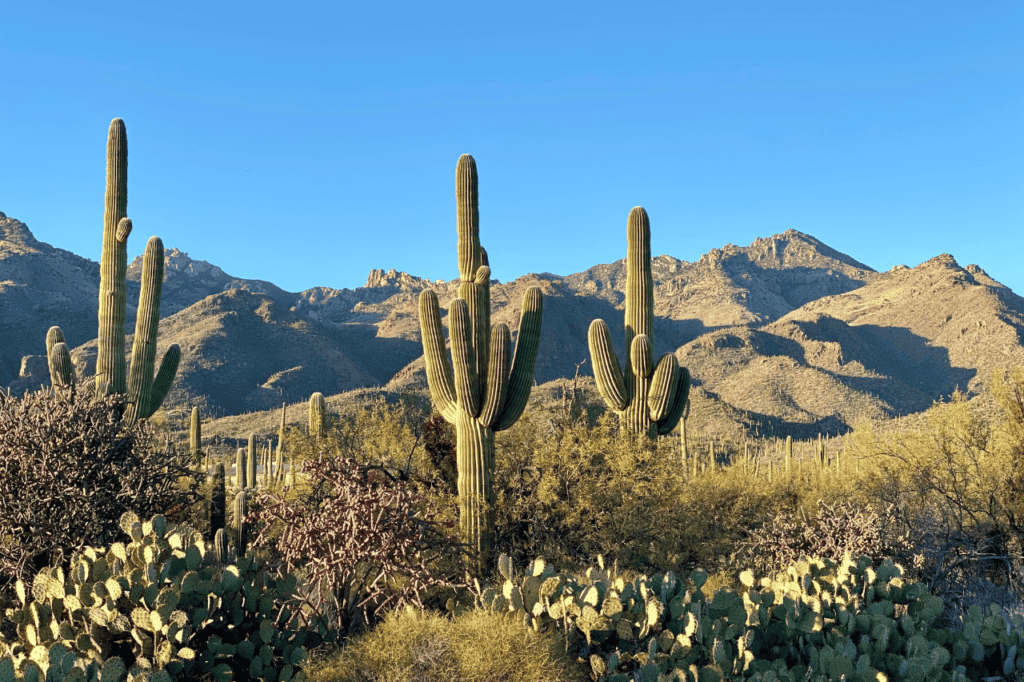
February in Southern Arizona offers mild temperatures, ranging from the mid-60s to the low 70s, making it an ideal escape from winter. Explore diverse hiking trails, attend cultural events like the Tucson Gem & Mineral Show, and visit charming historic towns such as Bisbee and Tombstone for a well-rounded experience in this region.
Go Back In Time To The Old West In Tombstone
Just like the Arizona Rennaissance Festival, Tombstone, Arizona, beckons visitors to step back in time during February. However, instead of transporting you back to a mystical medieval era, Tombstone brings visitors to the rough and tumble times of the Old West.
Famous for the legendary Gunfight at the O.K. Corral, Tombstone is a living testament to the Old West. While Tombstone is a historic city open to the public year-round, in February, the weather is notably pleasant, with daytime highs ranging from the mid-60s to low 70s.
Wander along the wooden boardwalks of Allen Street, where historic buildings and saloons transport you to the days of Wyatt Earp and Doc Holliday. With fewer tourists during this time, you can delve into Tombstone’s rich history, attend engaging reenactments, and visit attractions like the Boothill Graveyard and the Bird Cage Theatre without the usual crowds.
How to Get to Tombstone: From Tucson, take the I-10 to Highway 80, then continue south until you reach signs for Tombstone. It’s about an hour and fifteen minutes from Tucson.
See Saguaro National Park
For those seeking a reprieve from the cold and yearning for breathtaking hikes, Saguaro National Park is an excellent choice. With average winter temperatures soaring into the high 60s, it stands out as a premier destination to thaw out and partake in outdoor adventures in February.
Upon entering the vast 143-square-mile park, you’ll be captivated by the towering saguaros. Some of these cacti reach an impressive 50 feet and live a lifespan of up to 125 years.
The park is divided into two distinct sections: East Saguaro, characterized by its mountainous terrain and abundant hiking and backpacking trails, and the West side, home to a denser Saguaro forest.
History enthusiasts can explore the Signal Hill Petroglyphs, an accessible trail leading to a vantage point offering views of Tucson’s mountains and ancient petroglyphs left by the Hohokam people over 800 years ago.
How to Get to Saguaro National Park: Saguaro National Park is only thirty minutes away from Tucson International Airport.
Go to the Tucson Gem Show
In February, Tucson transforms into a gem enthusiast’s haven with the annual Tucson Gem Show. The city hosts numerous events over several weeks, starting in January and continuing throughout the second month of the year.
The show features hundreds of vendors from around the globe showcasing rocks, fossils, gems, jewelry, and crafts. Among the highlights is the renowned Tucson Gem & Mineral Show at the convention center, the oldest and largest of these events.
With serious collectors and buyers in attendance, securing accommodations early and navigating through the bustling events is advisable.
How to Get to Tucson: Tucson is a little less than two hours south of Phoenix. It’s just a straight shot down the I-10.
➡️ For 15 of the Best Peak Hikes Near Tucson, Arizona, click here! 🥾
Visit The Eclectic Town of Bisbee
February in Bisbee, Arizona, is a delightful time to explore this historic mining town nestled in the Mule Mountains. With daytime temperatures ranging from the comfortable mid-50s to low 60s, the weather offers an ideal backdrop for wandering through Bisbee’s charming streets.
The town’s well-preserved architecture and vibrant arts scene come to life as you stroll along its hilly terrain. Bisbee’s mild winter climate makes it enjoyable to visit landmarks like the Copper Queen Hotel and the Lavender Pit, a massive open-pit copper mine.
Art enthusiasts can explore the Bisbee After 5 Artwalk, a free monthly event occurring on the second Saturday of every month. At the Artwalk, guests can wander through galleries and studios that open their doors for an evening celebration of creativity.
The quirky and fun Bisbee Mardi Gras Parade is another February highlight, featuring colorful floats, costumes, and lively festivities.
Whether you’re drawn to history, arts, or simply soaking in the town’s distinctive atmosphere, Bisbee in February offers a captivating experience in a setting that seamlessly blends the old and the new.
How to Get to Tucson: Located close to the Arizona-Mexico border, Bisbee is a little less than a two-hour drive from Tucson. Follow Highway 80 out of Tucson, continue past Tombstone, and the highway will run directly into this strange little town.
➡️ Book a guided E-bike tour of Bisbee’s history and culture here! 🚲
What To Pack When Visiting Arizona in February?
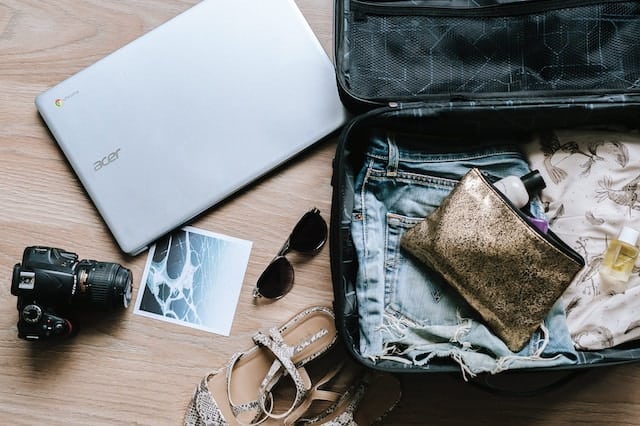
When packing for a trip to Arizona in February, it’s essential to prepare for the diverse weather conditions across the state.
In the southern regions, including Phoenix and Tucson, where temperatures can reach the pleasant 60s or 70s during the day, pack lightweight and breathable clothing such as:
However, be mindful of cooler evenings and mornings, so include layers like a light jacket or sweater.
In the northern areas, like Flagstaff and Sedona, where temperatures may hover in the 40s with potential snowfall, pack:
- Warmer layers
- A waterproof jacket
- Sturdy, waterproof footwear suitable for possible snowy trails
Regardless of your destination within Arizona, include essentials such as:
- Sunscreen
- A wide-brimmed hat
- A reusable water bottle to stay hydrated
That last one is very important as the desert climate can still lead to sun exposure and dehydration even in the winter.
If planning outdoor activities, consider packing:
- Hiking boots
- A daypack
- A camera to capture the stunning landscapes
Lastly, bring appropriate travel documents and any specific items you may need for planned events or festivals taking place during your visit.
📃Check Out My Guide For An All-Encompassing Arizona Packing List.
Frequently Asked Questions About Visiting Arizona in February

No guide would be complete without reviewing some of the most frequently asked questions. Here are the most common FAQs I get about visiting Arizona in February.
Is February a Good Month To Go to Arizona?
Yes, February is a great month to visit Arizona. In fact, it’s one of the best months of the year to explore this southwestern state. The weather is generally mild and comfortable, making it ideal for various outdoor activities across the state.
When Is the Ideal Month for an Arizona Visit?
The ideal month for an Arizona visit often depends on personal preferences. February is excellent for those seeking a balance between mild temperatures, fewer crowds, and diverse outdoor experiences.
But if you’re itinerary is full of outdoor activities like camping or swimming, then you might want to wait until April or May when the weather starts to heat up a bit more but the scorching temperatures of summer haven’t begun to simmer.
Is Sedona Worth Visiting in February?
Sedona is absolutely worth visiting in February. The crowds are smaller, and the weather is perfect for exploring the stunning red rock landscapes and enjoying outdoor activities with a more serene atmosphere.
Additionally, if you happen to visit Sedona after it snows, the white powder on the red mountains is incredibly beautiful to look at.
What Are Some Warm Places To Visit in Arizona During February?
In February, southern parts of Arizona, including Phoenix and Tucson, offer warm temperatures ranging from the 60s to 70s Fahrenheit. These areas provide a pleasant escape from colder climates and allow visitors to engage in outdoor adventures.
Are there outdoor activities to enjoy in February?
February is an excellent time for outdoor activities in Arizona. From hiking in the desert to skiing in the northern mountains, visitors can explore diverse landscapes and engage in various adventures.
Final Thoughts on Visiting Arizona in the Winter
Arizona is one of my favorite U.S. destinations. After all, I did live there for an entire decade. Not only is the climate fabulous (most of the time), but the history and culture of this western state are so much fun!
Arizona is an incredible place to visit year-round (yes, even in the summer!), but in February, so much comes to life across the state. Whether you want to spend your trip hiking in the desert amongst the saguaro or tearing up powder in the snow-capped mountains of Flagstaff, the choice is yours! You could even do both if you plan your trip right.
I hope you’ve enjoyed reading this guide to visiting Arizona in February and that it’s helped you in planning an awesome trip to State 48 this winter.
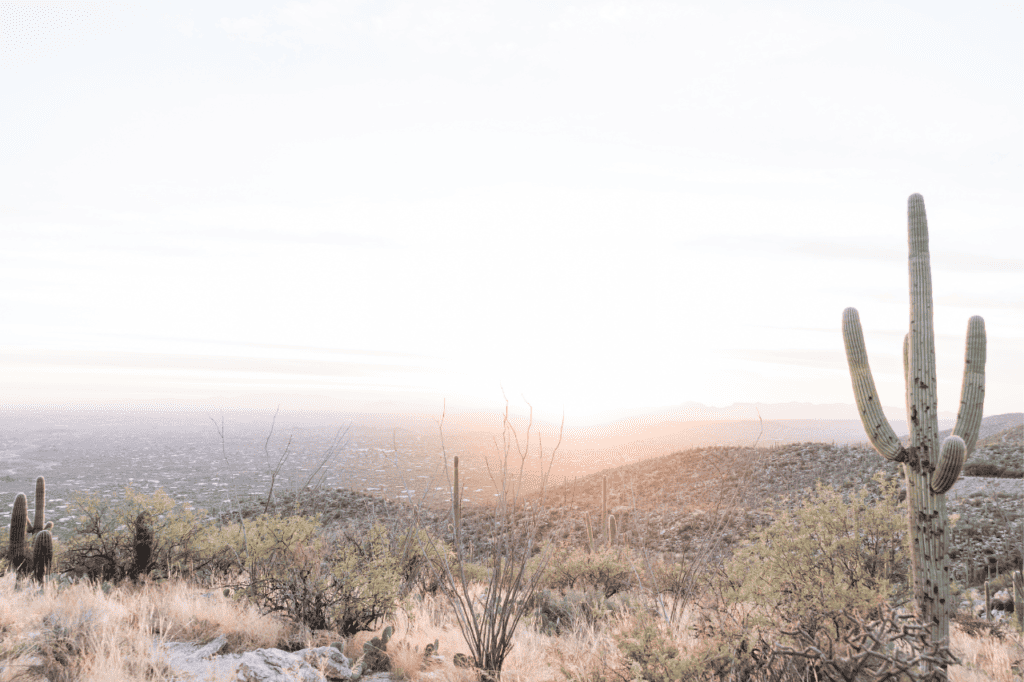
Additional Resources:
Ready to Book Your Phoenix, Arizona Trip?
Here are a few helpful services:
Booking.com | Find a comfy place to lay your head after a full day of adventuring.
Vrbo | If you’re looking for a more homey vibe, these rental homes might do the trick.
Expedia | Whether you’re looking for some wheels or a flight, you can find a way to get to your destination here.
Get Your Guide | Find local attractions and tours and book tickets to your excursions.
Viator | Another great resource for local attractions and tours.
TSA | If you’re flying, check out the TSA page to make sure that you pack to TSA regulations.
World Nomads Travel Insurance | Feel safe while traveling with simple and flexible travel insurance.

